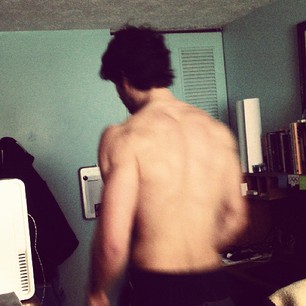I train differently than most. I do an exhaustive warm up. I end some sessions with light aerobic circuits. I don’t train to failure. I don’t follow the rules. And it prides me to say that I’ve seen the greatest gains of my life the past two months. Considering my foot was smashed into smithereens [...]
 I train differently than most. I do an exhaustive warm up. I end some sessions with light aerobic circuits. I don’t train to failure. I don’t follow the rules. And it prides me to say that I’ve seen the greatest gains of my life the past two months. Considering my foot was smashed into smithereens earlier this year, my progress is, well, kind of a big deal. Just kidding. Kind of.
I train differently than most. I do an exhaustive warm up. I end some sessions with light aerobic circuits. I don’t train to failure. I don’t follow the rules. And it prides me to say that I’ve seen the greatest gains of my life the past two months. Considering my foot was smashed into smithereens earlier this year, my progress is, well, kind of a big deal. Just kidding. Kind of.
From the exterior, my training is basic. Squats, deadlifts, presses, and pulls. The usual fare. But there is more to it that. Without knowing the complexities, however, it looks haphazard. Take a session from earlier this week, for example. It’s children’s gymnastics meets deranged powerlifting. But, alas, this has been the norm the past two months.
Warm Up – joint rotations, limb swings, chin-ups x 30, push-ups x 30, squats x 30, jumping jacks x 150
Strength – floor presses, chin-ups
Jacked – dumbbell press, bear walks, barbell row, inch worms, barbell curls, b-skips
Gymnastics – planches, forward rolls, handstands, left shoulder rolls, front levers, right shoulder rolls, l-sits
As I bear crawled up and down my garage, I told myself that I felt like some kind of animal beast stalking prey. Lo and behold, “beast mode training,” was born. So here are some things to know about Beast Mode Training:
- The warm up is the workout. I never touch a barbell before doing a basic dynamic warm up, thirty chins, push-ups, squats, and copious jumping jacks. Yes, even on lower body days.
- Strength is developed using a few basic movements, always kept submaximal and away from failure.
- Focus is on steady progress over time. One session doesn’t make or break it.
- Locomotion is intermixed with bodybuilding work to tax the aerobic system.
- Gymnastics and tumbling is a continuation of the aerobic work, done in a continuous circuit for time.
- The lower body is trained for strength and explosiveness.
- High intensity days are followed by low(er) intensity days. Just how low intensity depends on the season.
- Basic compound lifts are preferred, but those selected are arbitrary. Front squat instead of back squat? I’m not complaining.
- 50% of upper body pulling is done with a thick bar.
- 100% of upper body pressing is done with a thick bar.
- The “athletic” version of the Olympic lifts are used. (Expect a blog post on this soon.)
Beast Mode Training is designed for a recreational lifter that wants to retain their athleticism. Gymnastics holds are used because they are challenging, fun, and deliver a different kind of strength. Tumbling is used to stay youthful. There’s something about rolling end over end that harks back to more innocent times. And combining both gymnastics and tumbling in a circuit makes the abs catch fire. Front levers are the most underrated exercise in the history of physical culture. Nothing taxes the fabled “core” quite like them.
So if you’re looking for some change in your drab “routine,” take some principles from Beast Mode Training. It’s not all encompassing, and certainly not finalized. But it’s challenging, rewarding, and effective in its own way. Better yet, it gets you away from the barbell. Something that you should do anyway if you’re not a powerifter or Olympic weightlifter. I know you probably want more details, but I think it’ best to keep them under wraps right now. Beast Mode Training is still an infant. But, by all means, ask questions. I’ll answer as best I can. But the method is not near finalization.
TL;DR
Beat Mode Training is a mixture of bodyweight skills, basic barbell exercises, gymnastics, and tumbling designed for the recreational lifer that wants to better or maintain their youthful exuberance and athleticism.
What do you think about it? Drop me questions below.
Photo Credit: Image 1
